Software Development Under Control

At the heart of any location based display system, either in the real world or in
the virtual world is the display itself. The signage display is the primary means
that the casual observer will become informed of the product or service being marketed.
The AdSoft system has a more complicated display scheme than a standard single surface
bill board. A bill-board may have two sides, a front and back, but almost never
has a left or right side display surface. The AdSoft system does by using what is
called a "Display Prim". The display prim is a three-dimensional cubic or rectangular
shape that has front/back and side/side display surfaces. This allows two separate
graphics to be used with each advertisement.
The terminal is the base unit that performs all communication with Code4Software
servers, retrieving ads to be displayed, and relaying impression/request activity
back to the Code4Software database systems. Each terminal has a unique identifier,
and is initially created within the database system, before it is deployed in the
virtual world.
Crucial to tracking terminal activity is a system for uniquely identifying terminals.
This is accomplished through the use of the AdSoft Web Application (AWA). The AWA
is used to create a terminal definition record in the database, which then provides
the unique Terminal ID.
Once the in-world terminal is initialized, it will then retrieve the correct network
advertising queue (ad rotation) and transmit the impression and request activity
such that it is correctly attributed to that terminal.
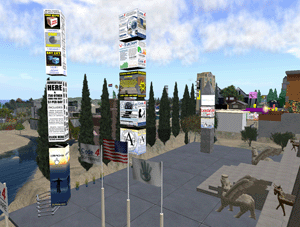
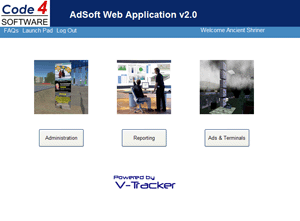
AdSoft is available for porting to your virtual world today. It is currently in
version 2.0 and has been running on the Second Life Grid Platform for the past two
years, and in its current version since December 2007. It currently processes over
75 million ad rotation transactions a month on top of recording upwards of 15 million
impression minutes per month.
The technology is available for licensing to other virtual worlds with a 30-day
turn around for porting in most circumstances.


The AdSoft system includes advertising content management, advertising rotation
queue management, terminal management, and reporting, all coupled with a multi-tier
role based security system.
All of these tools are available over the Web, with zero in-world activities necessary
to change which ads specific terminals are displaying. A rotation of ads can be
set up to run across 1000 terminals, or play on just one, providing the ultimate
flexibility.
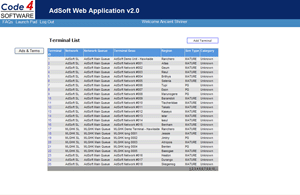
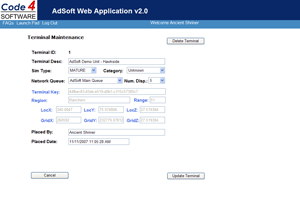
Display terminals exist to display advertisements. Advertisements are created within
the AWA in the form of Ad Definitions (or Ad Def). Each Ad Def contains the display
and behavior definitions for the particular advertisement. The behaviors are defined
as Ad Types, and the graphic display isn’t included in the Ad Def, but rather the
texture key for the graphic. Each Ad Def is assigned a Customer, Category, and Campaign.
This allows like-type ads to be tracked and grouped together for reporting purposes.
The Click-Thru defines which scanner object is tracking the in-bound traffic coming
from this Ad Def (in the case where teleport or landmark is an Ad Type).
Advertisements are displayed on terminals on a set rotation that are one minute in length. Each display prim will update in order, going from bottom to top. The number of minutes of display time will vary depending upon the number of display prims. The more display prims, the longer the display time for each advertisement, as it equals one minute display time per display prim in the terminal. A three display prim terminal will have ads that display for three minutes before rotating out, and a five display prim terminal will display ads for five minutes. These rotations are defined within the system as Ad Queues.
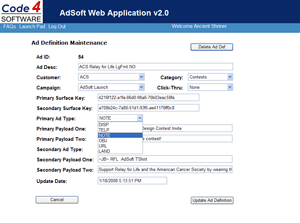



There can be billions of ad queues defined, effectively making it infinite. Each
terminal uses a defined Ad Queue and this allows a one-to-one relationship to be
created where a single specific ad queue can be played on a single terminal. Our
initial networks have used one or two ad queues to control hundreds of terminals
each. By changing the Ad Queue Definition within the AWA, you are effectively changing
what each live terminal that is using that Ad Queue will display in near real-time.
Near real-time is used because it can take up to one minute per display surface
to update, thereby giving a maximum wait time of five minutes for a five display
prim model terminal.
While terminal, content, and ad rotation management are great features, the major
value of the AdSoft system comes from the detailed tracking and metric results of
that tracking. AdSoft was designed from the foundation of V-Tracker, and used the
best of the lessons learned from the world’s first virtual world metrics capture
and web based reporting tool.
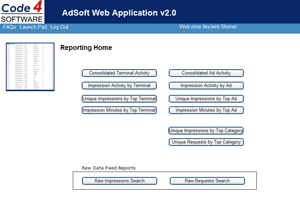
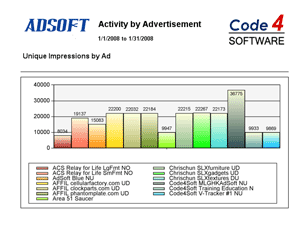
The advertisement content and activity have a great deal to do with the request
rates. Our findings show that directing the viewer to act ("Click Here!") and offering
a free item results in much higher request/click-through rates.
AdSoft runs The Advertisers
Guild networks, the largest centrally controlled ad network on the Second
Life Platform, where over 150,000 unique avatars generate over 15 million impression
minutes per month (as of July 2008).
